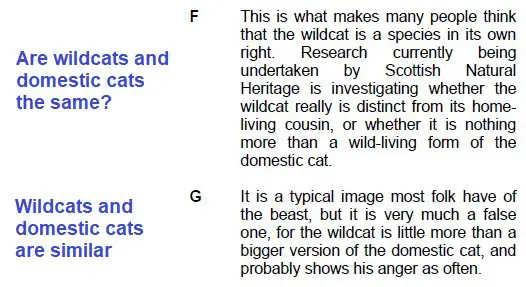Reading and Use of English Part 7
I’m going to start this article with a bummer. Reading and Use of English Part 7 might be the most dreaded task in the whole exam paper. It is a long (and I mean loooong) reading task in which candidates need to show some very unique skills and most of my students don’t enjoy doing it at all.
However, with its requirements and the prospect of two marks for each correct answer, Reading and Use of English Part 7 has some intrigue and deserves a closer look.
In this article, you are going to learn what a typical Part 7 task looks like, what you need to be careful with and how exactly you can (and should) approach this part in order to sail smoothly and get through it safe and sound with lots of marks on your score sheet.
Before we jump right into it, I should remind you that Part 7 is only one of eight tasks in Reading and Use of English and it is definitely worth finding out a little bit more about the general structure of the paper before analysing each individual task. Luckily, I’ve got you covered with a separate article on the topic and you can simply follow the link below to find out more.
>>> Learn more about Reading and Use of English <<<
What do you have to do in Part 7?
Part 7 – Gapped text: You get a text from which six whole paragraphs have been removed. You have to choose the missing paragraphs from seven possible answers so there is one paragraph you don’t need to use.

Above you can see an example text for Reading and Use of English Part 7. The missing paragraphs are clearly marked from 41 to 46.

Following the text, you always see seven paragraphs A-G to fill in the gaps with. Note that there is always one extra paragraph to make the whole task even more difficult than it already is.
Reading and Use of English Part 7 examines your understanding of how the text is structured as well as its flow and the development of opinions and ideas rather than just simple language links.
Together with parts 1, 5, 6 and 8, this part builds the reading portion of the exam paper. In order to become fully confident with the structure of the exam, I recommend reading my other article on the topic. It shows you how Reading and Use of English works and what you should consider before getting into too much detail with every single task. If you are interested, follow the link below.
>>> Learn everything you need to know about Reading and Use of English <<<
The 3 most common problems with Part 7
In Part 7, just like in parts 5, 6 and 8, you read a longer text which comes with its unique requirement to answer the questions correctly. Overall, it is the longest text of them all as, in addition to the text itself, you also have to go through different paragraphs so there are quite a few things that can go wrong. I have compiled the three most common ones based on my experience as a teacher.
Lack of reading skills
At this level, it shouldn’t be a huge problem to read longer texts in English, but, unfortunately, I see many candidates who struggle with the length of the text and paragraphs in this part.
It is absolutely crucial to be able to read at a high speed whilst understanding what your looking at, not only in Reading and Use of English Part 6, but in all the different tasks. However, Part 6 with its additional word count emphasises this even more.
Candidates don’t know how to do the task
This problem sounds almost unreal, but it definitely happens that candidates approach me to tell me that they are not sure how to find out which paragraph goes in which gap.
The solution to this problem is quite simple and I’m going to show you later on in this article in detail how to solve it.
To give you a short preview, the key to success is to have a specific plan that you can follow every time you do this task. This way, you learn what to look for in order to choose the correct paragraph for each gap.
Timing problems
Time management is such a big issue in Reading and Use of English and this really ties in nicely with the previous two problems.
If you lack the reading speed and understanding necessary or a clear plan and structure for how to do the task, you will inevitably get into time trouble. To avoid this you, once again, need to know what to do and how to do it, but in the following section, you will find out how to ace Reading and Use of English Part 6.
Tips and strategies for Part 7
Once you are aware of problems you might have with Reading and Use of English Part 7, you need to go to work and find out how to get rid of these issues. In this section of the article, I’m going to show you the good stuff. We’ll start with some general advice before we dive into how exactly you cam master Part 7.
General tips
Practice is the key to success in C1 Advanced and there are a few small things that can help you with your language in general and certain parts of the exam in particular while other forms of practice help you more with specific tasks.
The most important piece of advice I can give anyone who wants to prepare for C1 Advance is to get into an English routine as soon as possible. General language development is terribly underrated and is met with only little love even in many preparation classes.
However, I recommend immersing yourself in the language as much as you can. Of course, you might not be in an English-speaking country or have a lot of time on your hands due to work, studies and other necessary activities in your life. The good thing is that just ten minutes per day can already make a difference.
Simply read or listen to an article or podcast, or watch a show or film or your preferred streaming service. Whatever you can do, do it. Your brain will process the language that’s coming in (just make sure that you can understand the majority of what you consume) and with consistency comes improvement.
Use your train ride to work or your bus journey to school for a little bit of English practice and you might see changes quickly.
Follow a plan
As with all the other parts in Reading and Use of English, Part 7 requires you to have a clear idea of what you need to do in order to get through the task effectively and efficiently. While too many candidates just go to the exam and try to somehow complete everything, it is crucial for you to know what to do and how to do it.
I always strongly recommend following a step-by-step plan because it is something that is easy to memorise and use, which comes with two big advantages. Firstly, you feel less stressed and more confident as you know what is happening at any moment throughout the exam and secondly, it helps you manage your time efficiently.
With all that being said, let’s have a look at what this plan might look like for Reading and Use of English Part 7.
- Read the title and text
- Analyse the paragraphs
- Analyse the text and find a match
- Read the text again
In the following sections, I’m going to go into more detail on what each step means and what you have to do.
Read the title and text
This step is really important as it gives you an idea of what the text and its different parts are about. Remember, in Reading and Use of English Part 7, you need to demonstrate your ability to understand the flow and progression of a longer text so it is key for you to figure out what the topics of the text as a whole and the different parts are.
It can be a good idea to make a note next to each paragraph to check what they are talking about. This way, you get a visual representation of the flow of the text.

Above you can see the first two paragraphs of your example from earlier and I’ve already added my little comments on the left. They are really short and get straight to the point. You don’t want to spend too much time on this step, but you also want to make sure that you can simply read the comment and remember immediately what each paragraph talks about.
Analyse the paragraphs
After looking at the text, we should now spend some time on the paragraphs. As Reading and Use of English Part 7 looks at the progression and development of the text as a whole rather than just simple facts or connections between words, it makes sense to look at the different paragraph options the same way we do with the text.
Quickly read the different possible answers and note down what each of them talks about.

Here you have it. Just as we did in the previous step, we also summarise the paragraphs so we know what they are talking about. However, the analysis is not completely done. We should also look at certain words that might help us connect the paragraphs to what is said in the text. Let’s take another look at our two examples:

In paragraph F, we find the determiner ‘this’ while in G, we can see the pronoun ‘it’. Both of them are not explained in their respective parts so there must be some information in the text that lets us connect the paragraphs to other sections in the text.
Analyse the text and find a match
With the previous two steps, we’ve laid the groundwork for the actual task, matching the paragraphs with the gaps in the text. Our goal is to find links between the different parts that add to the text’s progression.
Checking our example once again, we find the following:

Remember that we found the pronoun ‘it’ in paragraph G and wondered what it means? ‘It’ means the painting on the author’s wall.
This is complemented by the next paragraph in the text. While paragraph G describes the similarities in personality between a wildcat and a domestic cat, the following section in the text points out the physical differences. This contrast adds to the logical development of the text so paragraph G is a perfect match.
Of course, you need to repeat step 2 and 3 for the other gaps as well, but I hope that the idea behind it has become clear to you.
Read the text again
The last step of your plan is just as important as the other ones, but many people neglect it and lose marks because of that.
Once you’ve filled in all the gaps, make sure that you read the text again. If you made a mistake, it will show at this point. You will find that the text simply ‘doesn’t sound right’ when you go through it again with the paragraphs in the wrong places and you can make late adjustments before moving on to the next task.
Therefore, always proof-read your work to secure all the marks that you’ve worked so hard to score in the first place.
Other tips
Reading and Use of English Part 7 has a distinct advantage over some of the other tasks of the exam paper as you receive two marks for every correct answer. Hence, it is a good idea to take a little bit more time to go through the text and paragraphs in order to maximise the outcome.
Also, as I’ve mentioned at the beginning of this article, it is a good idea to learn more about Reading and Use of English as a whole. While it is really important to look at the different tasks in detail, it is also beneficial to work out certain global strategies which can help you tremendously with time management and your level of confidence. If you want to find out more (and if you haven’t checked it out already), follow the link below.
>>> Everything you need to know about Reading and Use of English <<<
What is there left to say?
In this article, I’ve shown you what Reading and Use of English Part 7 looks like, what the most common problems are and how you can get ready for the task.
It is now up to you to take all this information and put it to practice. I hope my article will help with that.
Lots of love,
Teacher Phill 🙂














